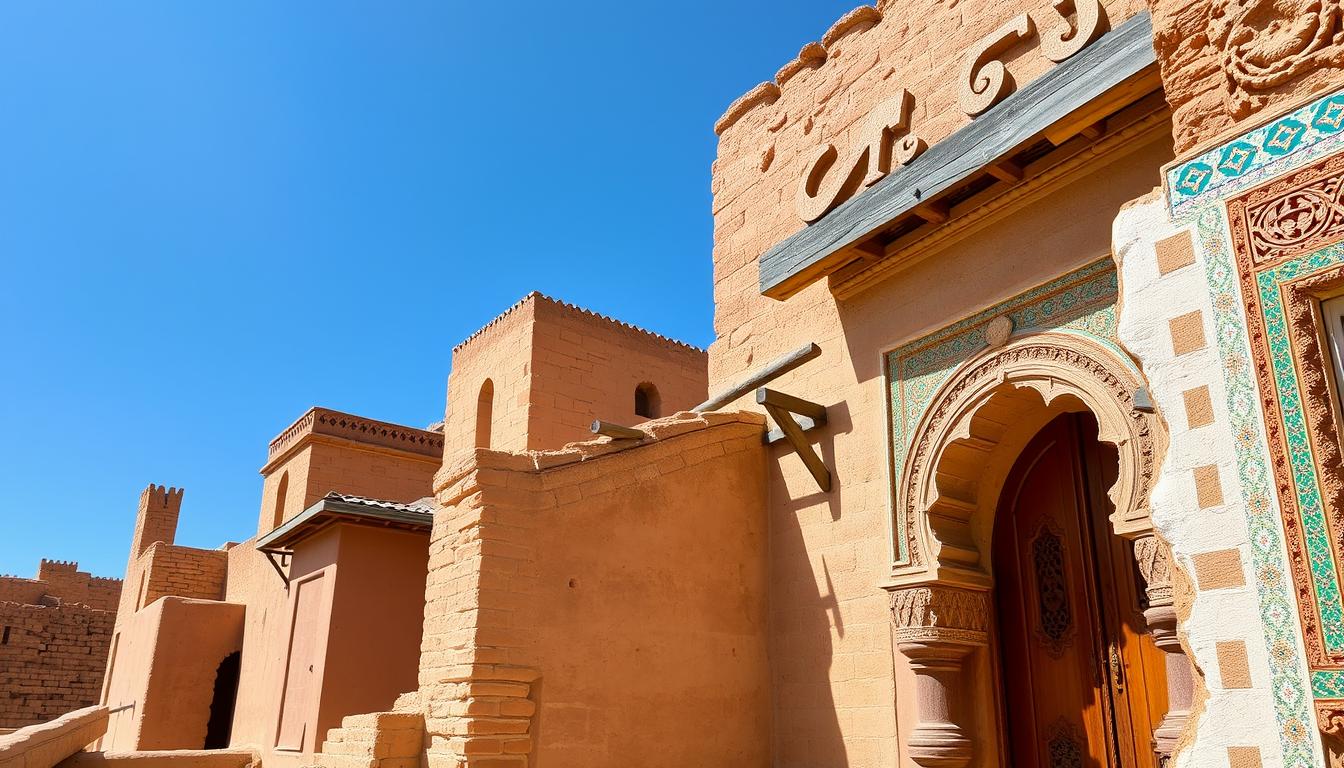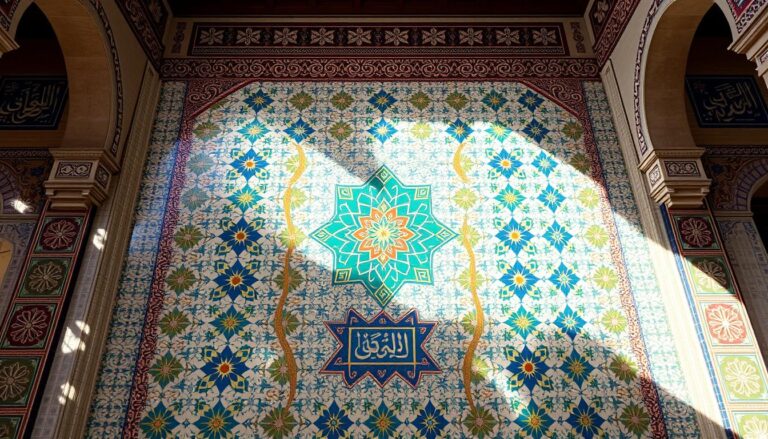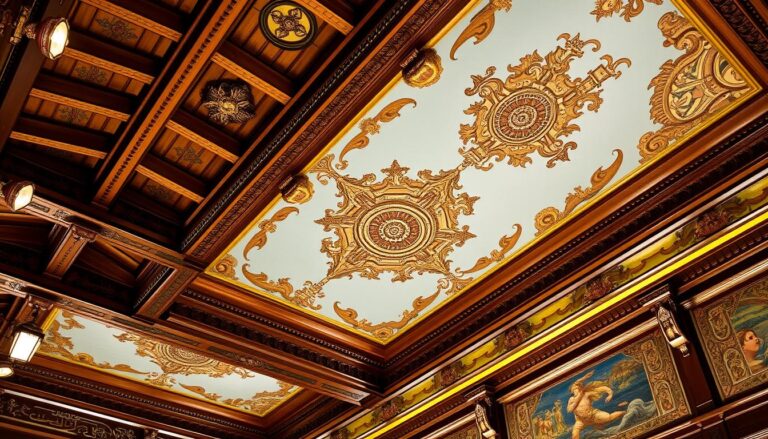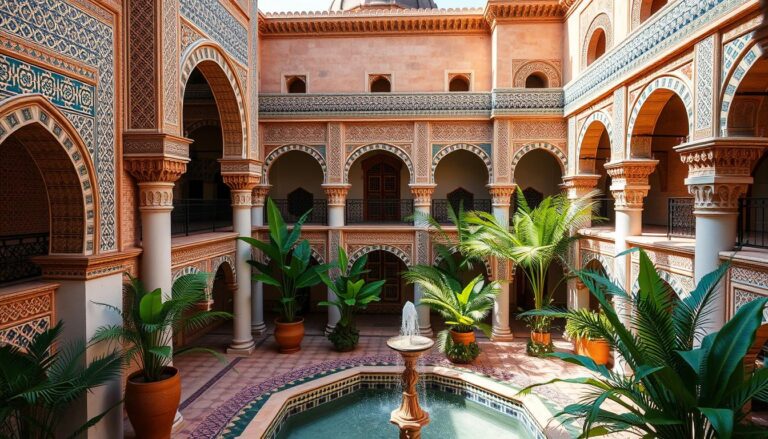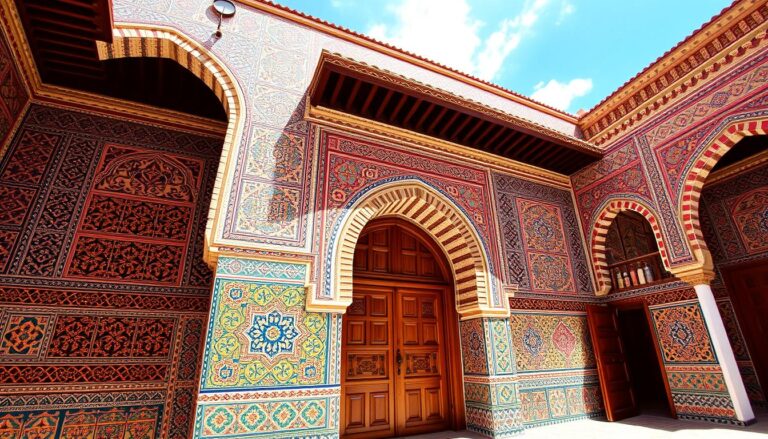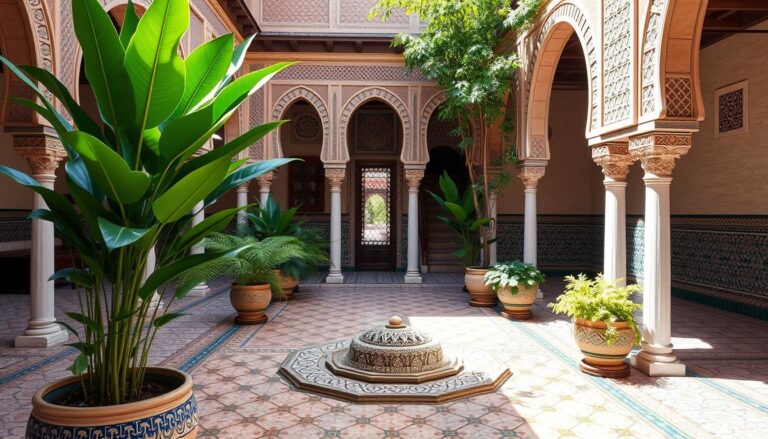Morocco’s architecture is a mix of many cultures, spanning centuries. It shows a rich history, from Roman ruins to Islamic monuments. The heart of this legacy is the traditional building materials used for generations.
Exploring Morocco’s traditional building materials tells a story of strength, sustainability, and culture. These natural materials, shaped by the country’s geography and climate, have shaped Moroccan architecture. They also show the importance of living in harmony with nature. Let’s discover how these materials have helped create Morocco’s architectural wonders.
Key Takeaways
- Moroccan architecture blends influences from Amazigh (Berber), pre-Islamic Spain, and the Islamic Middle East.
- Traditional Moroccan architecture features the use of natural materials like rammed earth, stone, and timber.
- Vernacular architecture in Morocco showcases the adaptation of Islamic architectural forms to local conditions and resources.
- The Berber peoples have made significant contributions to Morocco’s traditional building techniques and styles.
- Sustainable design principles are deeply rooted in Moroccan architecture, showcasing the use of locally sourced, environmentally friendly materials.
Morocco’s Rich Architectural Tapestry
Morocco’s architecture is a mix of cultures, from ancient Romans to Islamic styles. This North African country’s buildings show its long history. Each time period has left its mark on the buildings.
Ancient Roman and Early Islamic Influences
The Berbers were the first to shape Morocco, followed by Phoenicians, Carthaginians, and Romans. Places like Volubilis, Tingis, and Sala show Roman architecture’s impact.
In the 8th century, Morocco joined the Muslim world. The Idrisid dynasty made Fes a key city. This brought new architectural styles, like minarets and ornate gates.
The Berber Empires: Almoravids and Almohads
The Almoravid and Almohad empires (11th-13th centuries) shaped Moroccan architecture. They built new capitals and added unique features like muqarnas and zellige.
Places like the Tinmal Mosque and the Saadian Tomb Complex show their legacy. They use thick walls and intricate tiles.
“Morocco’s architectural tapestry includes a heavy influence of Islamic, Spanish, and French architecture blended with traditional Moroccan influences and urban design.”
Morocco’s buildings tell a story of its cultural history. They show the lasting impact of its people.
Traditional building materials in Morocco
Adobe Bricks: A Sustainable Foundation
The adobe brick is key to Moroccan architecture. It’s made from soil, sand, straw, and date palm fibers. These bricks keep buildings cool and blend well with the landscape.
The Berber people have kept this skill alive for ages. They teach it to their children, keeping the tradition alive.
Rammed Earth: Thermal Efficiency and Local Roots
Rammed earth is another common method in Morocco. It uses soil, clay, sand, and straw to make strong walls. These walls keep buildings cool in summer and warm in winter.
Materials like adobe bricks and rammed earth show Morocco’s smart use of nature. They prove the value of vernacular architecture. These buildings are both useful and beautiful, inspiring architects everywhere.
Vernacular Design for Desert Living
In Morocco’s dry climate, traditional architecture has developed to make homes comfortable without air conditioning. The riad, a Moroccan house with a central courtyard, is key. It cools naturally and offers a private space in crowded cities.
The riad’s design uses thick mud brick walls to control indoor temperatures. It also has wooden screens called moucharabieh for ventilation. Wind-catching towers, or malqaf, bring cool breezes inside, improving the home’s cooling.
These old building methods keep homes cool and show off Morocco’s culture and sustainable design. Moroccan architects use natural materials and smart cooling techniques. This way, they create homes that fit well with the desert and its landscape.
“The riad, a traditional Moroccan house built around an open central courtyard, is a prime example of this. The central open space provides natural cooling and a private oasis in busy urban areas.”
Morocco’s vernacular architecture shows how to make homes comfortable in the desert. It uses thick walls and wind-catching towers. This approach inspires today’s architects to build in harmony with nature.
Blending Tradition with Modern Needs
Moroccan architecture has always been a mix of old and new. It uses traditional materials like clay and wood. But now, it also includes eco-friendly options. This makes homes that are beautiful and good for the planet.
Moroccan craftspeople keep old building skills alive. They teach others, making sure beautiful, sustainable buildings continue. Today, old riads have solar panels, and new villas take inspiration from the past.
Designers worldwide admire Morocco’s mix of old and new. Places like the Mohammed VI Museum of Modern and Contemporary Art in Rabat show this. Moroccan architects lead in modern architecture and sustainable design. They keep cultural heritage alive while meeting new needs and innovations.
Morocco keeps its past alive while looking to the future. Its homes, old or new, show the strength of tradition and adaptation. They inspire architects and designers to explore new possibilities in modern architecture.
Conclusion
Moroccan architecture is a perfect mix of old and new, showing respect for the earth. It uses simple adobe bricks and detailed zellij tiles. These methods connect us to the past and teach us about sustainable living.
The history of Moroccan architecture is filled with cultural exchange and creativity. It shows how tradition and innovation can go hand in hand. Today, it inspires people everywhere, highlighting the cultural identity and heritage of Morocco.
Morocco’s building wisdom is a beacon for our times. It teaches us about the importance of sustainability and keeping our cultural traditions alive. By learning from Morocco, we can build a future that honors the past while embracing new ideas. This way, we create spaces that are beautiful and deeply connected to the earth and its people.
Source Links
- Moroccan architecture
- Moroccan Architecture: In-Depth Review of Styles in Morocco
- Architecture In Morocco: 15 Uniques Buildings Every Architect Must See
- Exploring the Richness of Moroccan Architecture – Cindrebay
- Discover the Marvels of Moroccan Architecture
- Moroccan Rugs: A Tapestry of Culture, Color and Craftsmanship
- Moroccan Architecture History | Global Morocco Exploration
- The Rich and Vibrant History of Moroccan Architecture.
- Morocco – a journey to traditional building crafts
- Modern Morocco: Building a New Vernacular
- The Timeless Design of Moroccan Homes
- Learning from the ancients, modern Moroccan architecture forges new identity | Africanews
- Villa Atika’s architecture: a fusion of tradition and modernity
- Proceedings of the GSAP 2006 Colloquium
- Morocco earthquake: why traditional earthen architecture is not to blame for the destruction communities have endured

The Editorial Team is a passionate group of Morocco enthusiasts dedicated to sharing the beauty, culture, and wonders of this captivating country. With diverse backgrounds and a deep love for travel, we strive to bring you engaging and informative content that inspires your Moroccan adventures. From uncovering hidden gems and sharing local insights to exploring mouthwatering cuisine and showcasing the vibrant lifestyle, our team is committed to providing you with valuable resources and exciting stories that enhance your exploration of Morocco. Join us on this journey as we celebrate the rich heritage and unforgettable experiences that make Morocco truly special.

